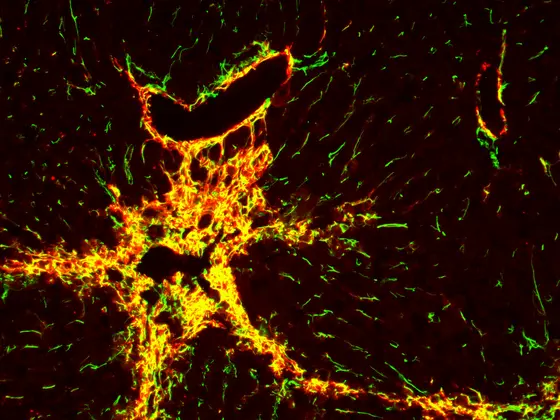Liver fibrosis, which is the progressive formation of scar tissue in the liver, is a massive medical problem. An estimated ten percent of the population is affected by liver fibrosis or its corresponding later stage, liver cirrhosis. A variety of causes can lead to liver fibrosis, the most widely recognized ones being alcohol consumption and virus-induced chronic liver inflammation. Other factors that can lead to scarring in the liver include the use of certain drugs, fatty liver disease and genetic disorders such as iron overload disease. As fibrosis progresses, the liver tissue becomes increasingly nodular, and the disease turns into liver cirrhosis, a dangerous condition that also drastically increases the risk of developing liver cancer.
The working group of Professor Hellmut Augustin at the German Cancer Research Center (Deutsches Krebsforschungszentrum, DKFZ) and the Medical Faculty in Mannheim at Heidelberg University has now detected a new molecule on the surface of hepatic stellate cells that is a major contributor to the development of liver fibrosis. Hepatic stellate cells are a type of specialized cell in the walls of blood vessels. Their functions in the liver include storing vitamin A and regulating blood flow. They are considered to be initiators of liver fibrosis: In the wake of liver damage, these cells produce key substances for the formation of scar tissue and release them into the surrounding environment. If the liver damage cannot be completely repaired by dividing liver cells, this scar tissue stays put, giving rise to liver fibrosis.
The scientists in Augustin’s group have now discovered a protein called endosialin on the surface of hepatic stellate cells that activates these cells and, thus, also promotes the production of scar tissue. Genetically modified mice whose cells had no endosialin developed considerably less liver fibrosis after prolonged liver damage than normal animals whose cells were able to produce endosialin.
Surprisingly, the absence of endosialin not only reduced scarring and the activation of hepatic stellate cells but also improved the regenerative capacity of the remaining liver cells without leading to proliferative growth of the liver. Hence, endosialin can influence the critical balance between scar formation and liver regeneration.
Endosialin also appears to play a role in human liver fibrosis: The scientists examined samples from healthy liver tissue and from liver tissue at various stages of liver fibrosis, through to cirrhosis, to determine their levels of endosialin.
“Endosialin is produced at very elevated levels primarily in the early, active phase of liver fibrosis," explains Carolin Mogler, first author of the publication. “Many molecules are produced at different levels after liver damage, but we were very surprised by the extent to which the stellate cells increase the production of endosialin. These findings help us better understand how liver fibrosis develops."
These findings, obtained in a basic research setting, are still a long way from potential clinical application. However, an antibody that blocks endosialin is already being tested in clinical trials with the goal of treating specific types of tumors. The scientists now plan to investigate whether this antibody might also be useful for treating other diseases such as liver fibrosis.
Carolin Mogler, Matthias Wieland, Courtney König, Junhao Hu, Anja Runge, Claudia Korn, Eva Besemfelder, Katja Breitkopf-Heinlein, Dorde Komljenovic, Steven Dooley, Peter Schirmacher, Thomas Longerich, Hellmut G. Augustin: Hepatic stellate cell expressed Endosialin balances fibrogenesis and hepatocyte proliferation during liver damage.
EMBO Mol Med 2015, DOI: 10.15252/emmm.201404246
A picture for this press release is available at: /fileadmin/news_import/images/Fibrosis-Man.jpg
Caption: Liver fibrosis in a mouse: Labeling of two characteristic proteins (yellow) shows pathogenic changes in the organ.
Source: Carolin Mogler, DKFZ



